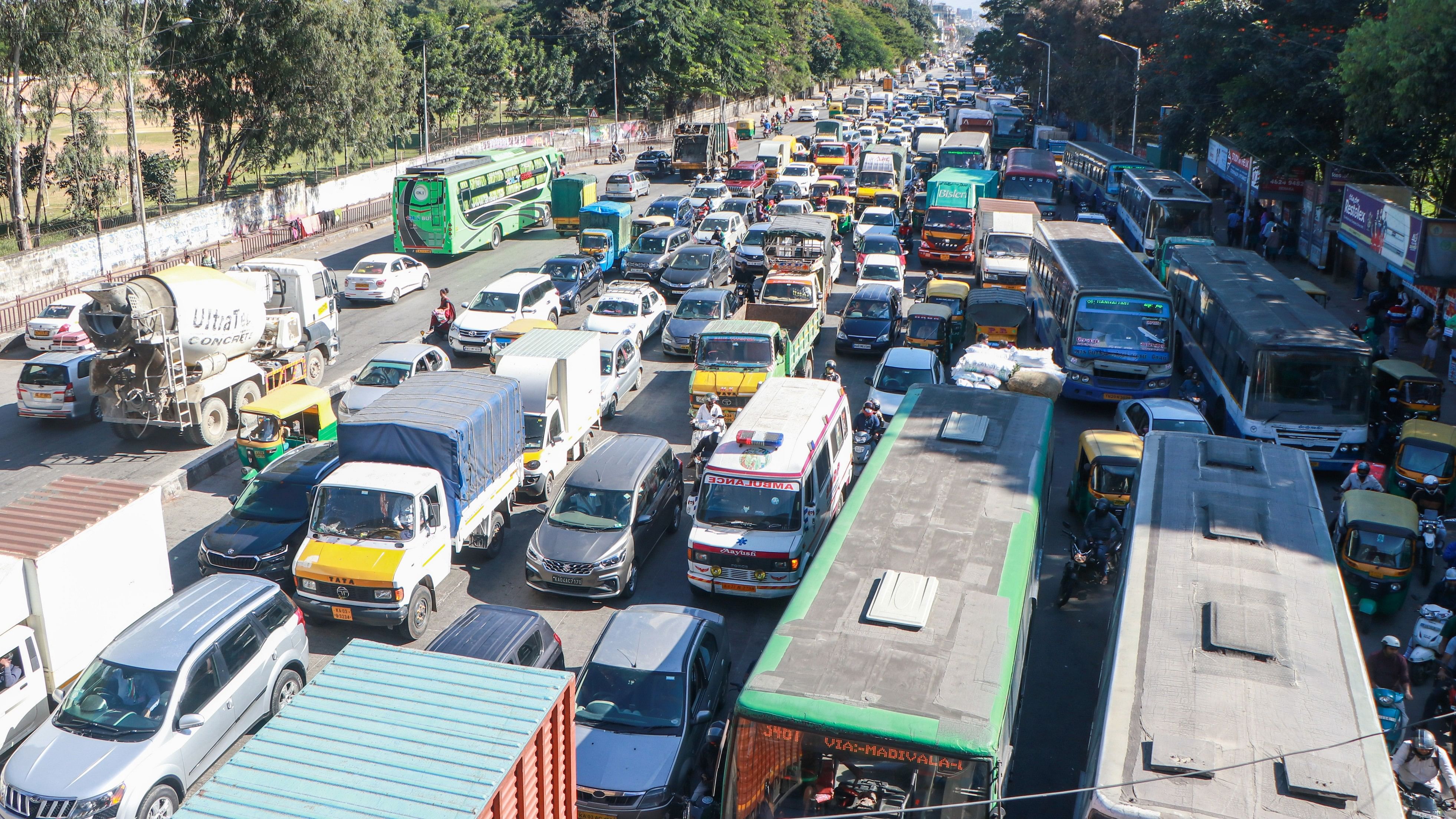
Hosur Road is one of the nine high-density traffic corridors, which the report has identified for implementing congestion tax.
Credit: DH Photo
A report prepared by the planning, programme monitoring and statistic department and the Federation of Indian Chambers of Commerce has recommended a congestion tax on private vehicles using nine high-density roads to enter Bengaluru during peak hours.
But introducing the tax in Bengaluru without boosting public transport will lead to a backlash, experts warn.
Singapore, London and Stockholm collect a congestion tax in their central business districts during peak hours. New York may roll it out next year.
A congestion tax can disincentivise the use of personal vehicles, drive up the adoption of public transport and speed up traffic movement, suggests the report, titled ‘Karnataka’s Decade — Roadmap to $1 Trillion Economy’.
Nearly 1.2 crore citizens waste 60 crore person-hours annually and almost 2.8 lakh litres of fuel per hour because of the congestion, the report says. Incidentally, on Wednesday, Bengaluru saw the worst traffic congestion in years (box).
Basics first
Speaking anonymously, a transport planning expert says the tax has succeeded in easing up traffic movement in Singapore, the first city in the world to introduce congestion pricing. But Bengaluru first needs to strengthen its bus, metro and auto coverage “so that if people want to leave their cars behind, they don’t feel inconvenienced”, he says.
Pawan Mulukutla from World Resources Institute (WRI), India, says a congestion tax regime is effective only if the tax is high enough for citizens to feel a pinch and when public transport options are ample to make a switch.
Bengaluru bicycle mayor Sathya Sankaran says the city needs more footpaths, cycling tracks, and TenderSure roads. Just discouraging four-wheelers is a myopic way of dealing with the problem, he says.
These experts unanimously say the revenue collected must be put back into the system to ease traffic snarls. “Potholes need to be fixed. Junctions need to be signalised and lanes uniformly widened,” says Pawan, who heads the integrated transport and mobility
programme at WRI India.
Street parking
Public transport champions like Sathya voiced the need to charge a parking fee on vehicles parked on the city streets in addition to imposing the congestion tax.
Citizens like HSR Layout resident Navaneethan Santhanam support the idea, saying it has yielded positive results in several US cities. “It should be stiff, at least Rs 40 to 60 an hour,” says the cofounder of a social data analytics startup.
Challenges
A Rajajinagar resident, who has lived in Singapore earlier, fears people may start taking arterial roads to avoid paying the tax on the ‘congested’ corridors.
M N Sreehari, advisor, Karnataka government, traffic, transport and infrastructure, says the congestion tax is not easy to apply within Bangalore Urban district. Road lengths here are shorter and not continuous, he explains. The Bengaluru report proposes collecting the tax through FASTag.
Unfair to citizens
College lecturer Loreto B would not like to be burdened with another tax. Calling it unfair, she argues that much of the congestion is due to metro construction, flyover building, digging for gas pipelines and other civic work.
Prathik Desai, founder of a media literacy startup, is sceptical if the congestion tax will make a difference to the traffic movement. “Those who can pay for a car and fuel will surely not mind another cess,” he says.
Where exactly?
The report recommends congestion tax on Ballari Road, Tumakuru Road, Magadi Road, Mysuru Road, Kanakapura Road, Bannerghatta
Road, Hosur Road, Old Madras Road and Old Airport Road. The Karnataka government has not responded to the recommendation yet.
Lessons from London
Shashi Verma is chief technology officer at Transport for London, a government body responsible for most of the transport network in
London. Traffic volumes in central London dropped by almost 20% soon after the congestion charge of 5 pounds (approx Rs 507 now) was enforced in 2003, he told Metrolife. The fee is deducted electronically once a day. It has now been revised to 15 pounds
(approx Rs 1,521).
“Today, people use public transport to come to work in the central area. Only traders, delivery agents, plumbers, taxi chauffeurs and other service personnel drive private vehicles and pay the congestion charge,” he explains.
A combination of “pull and push” has led Londoners to embrace public transport. London expanded its bus network by 60% between
2001 and 2005. Plus, the tightening of the parking fee hasbdiscouraged people from using private vehicles. Parking costs 4 pounds (Rs 406) an hour in central London.
According to Shashi, a congestion tax can’t be implemented overnight. London took nine years to prepare for its introduction in 2003. A special committee was set up, parliament introduced comprehensive legislation, public consultation followed, and the tech had to be perfected. “Cameras installed at critical junctions read the number plate and an integrated system charges drivers. User experience has to be slick,” he explains.
If the congestion tax has been effective, then why was London named the most congested city in a 2023 report? “The population of London was 73 lakh in 2003. Now it is 90 lakh. Employment and pedestrians have gone up. Roads have become narrower as we carved pedestrian footpaths out of them,” he says, commenting on the need to keep up with the times and enforce new measures, which London has.
New low
Some people were stuck along the Outer Ring Road for up to five hours on Wednesday. The vehicle count was unusually high — 3.5 lakh. The traffic department described the gridlock “unprecedented” and cited vehicle breakdowns and the long weekend as reasons